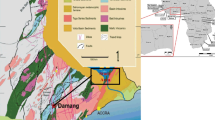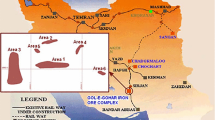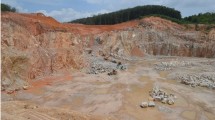Abstract
Flyrock is an undesirable phenomenon in the blasting operation of open pit mines. Flyrock danger zone should be taken into consideration because it is the major cause of considerable damage on the nearby structures. Even with the best care and competent personnel, flyrock may not be totally avoided. There are several empirical methods for prediction of flyrock phenomenon. Low performance of these models is due to complexity of flyrock analysis. Support vector machine (SVM) is a novel machine learning technique usually considered as a robust artificial intelligence method in classification and regression tasks. The aim of this paper is to test the capability of SVM for the prediction of flyrock in the Soungun copper mine, Iran. Comparing the obtained results of SVM with that of artificial neural network (ANN), it was concluded that SVM approach is faster and more precise than ANN method in predicting the flyrock of Soungun copper mine.









Similar content being viewed by others
References
Singh TN, Singh V (2005) An intelligent approach to prediction and control ground vibration in mines. Geotech Geol Eng 23:249–262
Monjezi M, Rezaei M, Yazdian A (2010) Prediction of backbreak in open pit blasting using fuzzy set theory. Expert Syst Appl 37:2637–2643
MSHA (1994) Accident investigation report: surface nonmetal mine, fatal explosives and breaking agent’s accident. Alton Stone Company Inc., Illinios
MSHA (1999) Report of investigation: fatal explosives accident. Surface nonmetal mine. Compass Quarries Inc, Paradise, Lancaster County
MSHA (1999) Accident investigation report: surface coal mine, fatal explosives accident. Appalachian Mining Services, Big Creek Mining, Inc., Mine no. 2, KY
Verakis HC, Lobb TE (2001) Blasting accidents in surface mines, a two decade summary. In: Proceedings of the 27th annual conference on explosives and blasting technique, vol I. International society of explosive engineers, Cleveland, pp 145–152
Institute of Makers of Explosives (IME) (1997) Glossary of commercial explosives industry terms. Safety publication, No. 12, Washington, DC, p 16
Holmeberg R, Persson G (1976) The effect of stemming on the distance of throw of flyrock in connection with hole diameters. Swedish Detonic Research Foundation, Report DS 1, Stockholm
Rehak TR, Bajpayee TS, Mowrey GL, Ingram DK (2001) Flyrock issues in blasting. In: Proceedings of the 27th annual conference on explosives and blasting technique, vol I. International society of explosives engineers, Cleveland, pp 165–175
Shea CW, Clark D (1998) Avoiding tragedy: lessons to be learned from a flyrock fatality. Coal Age 103(2):51–54
Siskind DE, Kopp JW (1995) Blasting accidents in mines: a 16 year summary. In: Proceedings of the 21st annual conference on explosives and blasting technique. International society of explosives engineers, Cleveland, pp 224–239
Ladegaard-Pedersen A, Persson A (1973) Flyrock in Blasting II, Experimental Investigation, Swedish Detonic Research Foundation, Report DS 13, Stockholm
Lundborg N (1974) The hazards of flyrock in rock blasting. Swedish Detonic Research Foundation, Reports DS 12, Stockholm
Bajpayee TS (2004) Blasting injuries in surface mines with emphasis on flyrock and blast area security. J Safety Res 35(1):47–57
Raina AK, Chakraborty AK, Choudhury PB, Sinha A (2011) Flyrock danger zone demarcation in opencast mines: a risk based approach. Bull Eng Geol Environ 70:163–172. doi:0.1007/s10064-010-0298-7
Tawadrous AS, Katsabanis PD (2007) Prediction of surface crown pillar stability using artificial neural networks. Int J Numer Anal Methods Geomech 31(7):917–931
Monjezi M, Bahrami A, YazdianVarjani A (2010) Simultaneous prediction of fragmentation and flyrock in blasting operation using artificial neural networks. Int J Rock Mech Min Sci 47:476–480
Monjezi M, Amini Khoshalan H, Yazdian Varjani A (2010) Prediction of flyrock and backbreak in open pit blasting operation: a neuro-genetic approach. Arab J Geosci, doi:10.1007/s12517-010-0185-3
Rezaei M, Monjezi M, Yazdian Varjani M (2001) Development of a fuzzy model to predict flyrock in surface mining. Safety Sci 49:298–305
Bishop CM (2006) Pattern recognition and machine learning. Springer, Berlin
Steinwart I (2008) Support vector machines. Los Alamos National Laboratory, information Sciences Group (CCS-3). Springer, Berlin
Cristianini N, Shawe-Taylor J (2000) An introduction to support vector machines. Cambridge University Press, UK
Wang L (2005) Support vector machines: theory and applications, Nanyang Technological University, School of Electrical and Electronic Engineering. Springer, Berlin
Martinez-Ramon M, Cristodoulou Ch (2006) Support vector machines for antenna array processing and electromagnetic. Universidad Carlos III de Madrid, Spain, p 120
Zhi-xiang T, Pei-xian L, Li-li Y, Ka-zhong D (2009) Study of the method to calculate subsidence coefficient based on SVM. In: The 6th international conference on mining science & technology procedia earth and planetary science, vol 1, pp 970–976
Zhang H, Wang HJ, Li YF (2009) SVM model for estimating the parameters of the probability integral method of predicting mining subsidence. Min Sci Tech 19:0385–0388
Little TN (2007) Flyrock risk. In: Proceedings of 30th ISEE conference on explosives and blasting technique, New Orleans, Louisiana, pp 35–43
Bhandari S (1997) Engineering rock blasting operations. A. A. Balkema, Rotterdam
Lundborg N, Persson A, Ladegaard-Pedersen A, Holmberg R (1975) Keeping the lid on flyrock in open-pit blasting. Eng Min J 176:95–100
Roth JA (1979) A model for the determination of flyrock range as a function of shot condition. US Department of Commerce, NTIS Report No PB81222358
Richards AB, Moore AJ (2002) Flyrock control—by chance or design. ISEE conference, New Orleans
Sanchez DV (2003) Advanced support vector machines and kernel methods. Neurocomputing 55:5–20
Quang-Anh T, Xing L, Haixin D (2005) Efficient performance estimate for one-class support vector machine. Pattern Recogn Lett 26:1174–1182
Stefano M, Giuseppe J (2006) Terminated ramp-support vector machines: a nonparametric data dependent kernel. Neural Netw 19:1597–1611
Lia Q, Licheng J, Yingjuan H (2007) Adaptive simplification of solution for support vector machine. Pattern Recogn 40:972–980
Agarwala S, Vijaya Saradhib V, Karnick H (2008) Kernel-based online machine learning and support vector reduction. Neurocomputing 71:1230–1237
Lin HJ, Yeh JP (2009) Optimal reduction of solutions for support vector machines. Appl Math Comp 214:329–335
Eryarsoy E, Gary J, Aytug H (2009) Using domain-specific knowledge in generalization error bounds for support vector machine learning. Decis Support Syst 46:481–491
Wu ChH, Tzeng GH, Lin RH (2009) A Novel hybrid genetic algorithm for kernel function and parameter optimization in support vector regression. Exp Syst Appl 36:4725–4735
Boser BE (1992) A training algorithm for optimal margin classifiers. In: Proceedings of the 5th annual workshop on computational learning theory. Pittsburgh, vol 5, pp 144–152
Wang WJ, Xu ZB, Lu WZ, Zhang XY (2003) Determination of the spread parameter in the Gaussian kernel for classification and regression. Neurocomputing 55:643–663
Dibike YB, Velickov S, Solomatine D, Abbott MB (2001) Model Induction with support vector machines: introduction and application. J Comput Civil Eng 15(3):208–216
Bray M, Han D (2004) Support vector machines identification for runoff modeling. J Hydroinformatics 6:265–280
Author information
Authors and Affiliations
Corresponding author
Rights and permissions
About this article
Cite this article
Amini, H., Gholami, R., Monjezi, M. et al. Evaluation of flyrock phenomenon due to blasting operation by support vector machine. Neural Comput & Applic 21, 2077–2085 (2012). https://doi.org/10.1007/s00521-011-0631-5
Received:
Accepted:
Published:
Issue Date:
DOI: https://doi.org/10.1007/s00521-011-0631-5




